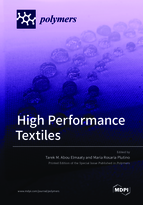High Performance Textiles
A special issue of Polymers (ISSN 2073-4360). This special issue belongs to the section "Polymer Applications".
Deadline for manuscript submissions: closed (28 February 2022) | Viewed by 28692
Special Issue Editors
Interests: supercritical fluid dyeing and finshing; development of new dyes; modification of fabrics and colorant to produce multifunctional textiles
Special Issues, Collections and Topics in MDPI journals
Interests: materials chemistry; green chemistry; nanotechnology; environmental remediation; advanced materials; functional coating; colloidal nanoparticles; smart and hi-tech textiles; (waste)water treatment; multifunctional hybrid materials and nanocomposites; sensing technologies; bio-based blended polymers; circular economy
Special Issues, Collections and Topics in MDPI journals
Special Issue Information
Dear Colleagues,
High performance textiles are one of the most recent advance of the textile and clothing industry. With input from imenient reearchers in the field, this book contributes a critical overview of key advancement in the field. Chapters binding the utilization of high performance textiles in such areas as medicine, protective clothing, heat and fire protection, industrial filtration, geotextiles, civil engineering and sustainable energy applications. Also, included evaluation of novel surface modification using nano particles, supercritical fluid, laser, irradiation with electron beam and plasma technologies for a wide scope of high performance textiles.Prof. Dr. Tarek M. Abou Elmaaty
Dr. Maria Rosaria Plutino
Guest Editors
Manuscript Submission Information
Manuscripts should be submitted online at www.mdpi.com by registering and logging in to this website. Once you are registered, click here to go to the submission form. Manuscripts can be submitted until the deadline. All submissions that pass pre-check are peer-reviewed. Accepted papers will be published continuously in the journal (as soon as accepted) and will be listed together on the special issue website. Research articles, review articles as well as short communications are invited. For planned papers, a title and short abstract (about 100 words) can be sent to the Editorial Office for announcement on this website.
Submitted manuscripts should not have been published previously, nor be under consideration for publication elsewhere (except conference proceedings papers). All manuscripts are thoroughly refereed through a single-blind peer-review process. A guide for authors and other relevant information for submission of manuscripts is available on the Instructions for Authors page. Polymers is an international peer-reviewed open access semimonthly journal published by MDPI.
Please visit the Instructions for Authors page before submitting a manuscript. The Article Processing Charge (APC) for publication in this open access journal is 2700 CHF (Swiss Francs). Submitted papers should be well formatted and use good English. Authors may use MDPI's English editing service prior to publication or during author revisions.
Keywords
- modification of fabrics
- dyeing
- high performance textiles
- surface modification
- multifunctional textiles








